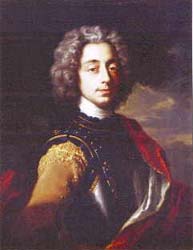

Dutch nobleman and composer. Born in the Castle of Twickel in the province of Overijssel on November 2, 1692, into a family of generals, admirals and personages holding high positions in the government of the Dutch Republic, gaining more and more wealth through marriage and their own influential positions. At the age of fifteen he accompanied his father, a Dutch ambassador, to the court at Düsseldorf, and after returning to The Hague in 1709 (to the family house on the corner of the Kneuterdijk) he studied law and other subjects at Leiden University. On the death of his father in 1717 he inherited the Twickel estates and began his Grand Tour of Europe. We know that he did not visit England, although the Elector of Hanover visited Twickel Castle in 1714 and returned as King George I in 1727. Wassenaer did, however, visit Paris and probably also Rome, Florence, Venice, Vienna and Prague. In 1723 he married Dodonea Lucia van Goslinga, an aristocrat from Friesland, and had three sons. He became a member of the Board of the Admiralty and a director of the East India Company. He was Ambassador to Paris in 1744 and in Cologne in 1746, and after a distinguished career as a Dutch diplomat he died on November 6, 1766, and was buried in the St Jacobskerk in The Hague.
In 1980 the Dutch musicologist Alfred Dunning was exploring the palace library at Twickel in the Netherlands. Here he discovered the scores for six concertos. Although the score is not in Wassenaer's hand he did write an introduction: 'Partition de mes concerts gravez par le Sr. Ricciotti Š',
Score of my concertos, engraved by Signor Ricciotti. These concertos were composed at different times between 1725 and 1740. When they were ready, I took them along to the musical gathering organized in The Hague by Mr Bentinck, myself and some foreign gentlemen. Ricciotti played the first violin. Afterwards I allowed him to make a copy of the concertos. When all six were ready, he asked permission to have them engraved. Upon my refusal he enlisted the aid of Mr Bentinck, to whose strong representations I finally acquiesced, on condition that my name did not appear anywhere on the copy and that he put his name to it, as he did. Mr Bentinck wanted to dedicate them to me; I refused absolutely, after which he told Ricciotti to dedicate them to him. In this way these concertos were published against my wishes. Some of them are tolerable, some middling, others wretched. Had they not been published, I would perhaps have corrected the mistakes in them, but other business has left me no leisure to amuse myself with them, and I would have caused their editor offence.
This answered the two questions that had long puzzled musicologists: who had composed these concertos, and why had the composer not identified himself. Indeed the foreword revealed that the composer had deliberately concealed his identity. Dunning's researches are documented in his publication Count Unico Wilhelm van Wassenaer. A master unmasked, or the Pergolesi-Ricciotti puzzle solved. (Buren,1980).
These concertos were probably all played between 1725 and 1740 at some of the regular private musical soirées of the highest social circles in The Hague. It was quite natural therefore that Wassenaer absolutely insisted on remaining anonymous as the composer at that time far beneath the dignity of a true nobleman. The concertos were first published at The Hague in 1740 by the Italian violinist Carlo Ricciotti (16811756) who often played first violin in the private concerts. He dedicated the publication to the Dutch nobleman Count Willem Bentinck (in whose house many of these concerts took place), and the composer is correctly referred to anonymously as being 'an illustrious hand'.
Ricciotti was also known as Charles Bachiche, and was nicknamed Bacciccia. Working in The Hague, Ricciotti belonged to a French opera company there from 1702 to 1725, eventually becoming its director. In 1740 he was granted a patent to print six concertos which, though published anonymously, we now know to be the Concerti Armonici of Unico Willem. Later, in 1755 that edition was reprinted by Walsh in London but the title page now credited Ricciotti with the actual composition. This confusion of attribution (and an incorrect numbering of the concertos) continued for many years including an otherwise excellent modern publication by Bärenreiter. After years of misattribution, first to the Italian Ricciotti, then later to Pergolesi, of the Six Concerti Armonici, the true identity of the composer was finally established beyond doubt, together with the probable reason for the anonymity and resultant confusion - simple modesty on the part of the author.